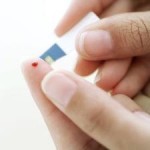I have been working with diabetics and diabetic testing strips for over 3 years, but I know most of my clients have dealt with this disease for much longer than that. This article gives some perspective as to how testing strips have evolved and changed over the years.
 Diabetes test strips have made it possible for individuals with diabetes to manage their illness on their own. It is a revolutionary product that has gone from giving only a general range to being able to give exact numbers allowing people to control their diabetes and take back their lives.
Diabetes test strips have made it possible for individuals with diabetes to manage their illness on their own. It is a revolutionary product that has gone from giving only a general range to being able to give exact numbers allowing people to control their diabetes and take back their lives.
The current diabetes test strips that most people are used to seeing and used to using are based off the detection of what is called blood analyte levels. A patent was applied for in 1994 and approved in 1996. The inventor of these strips is listed as Kevin J. Phillips.
Originally, it was difficult for individuals to self-test because of the level of equipment that was necessary to locate the analytes within human blood originally. The reason is that originally spectroscopy and spectroscopic equipment was too large and expensive to be effective for self-use.
When diabetes test strips were first used, the strips would change color due to a chemical reaction between the chemicals in the blood and the chemicals on the strip. The color would indicate the glucose level within the blood. The scale was written on a chart and it involved simply matching the color on the strip to the color on the chart.
This was not the most accurate of tests as it was difficult to judge the color since color perception not only varies between people but the poor vision associated with diabetes also affected perception making it difficult to gauge the color accurately. As technology advanced however, this test became based on a digital read out rather than basing it on the ability of the individual to match the colors making it more accurate. It also made it easier for home users to test their blood sugar.
The basics of the diabetes test strips have not changed over the years. They are the same as they were originally, chemically treated paper that is designed to react to chemicals in the blood. The meters that are used in home use to read the color and present a number representation.
The chemicals on the paper include enzymes, coenzymes, mediators and indicators, which are placed on the paper as a dry layer. This is why the strip reacts to the presence of glucose in the blood sample provided. It also helps to convert that sample into a readable signal for the meters.
Diabetes test strips have made it possible for individuals to be able to test their own blood sugar on a regular basis. The diabetes test strips patented in 1996 have brought a wealth of benefit to the medical community. As technology advanced, the use of these strips advanced and while they are still primarily the same as they were when they were originally created. They are a chemically treated paper coated with enzymes and mediators, indicators and coenzymes that reacts to the glucose in the blood in order to provide you with an electronic reading that has become accurate enough to give a reading from only a single small drop of blood.








